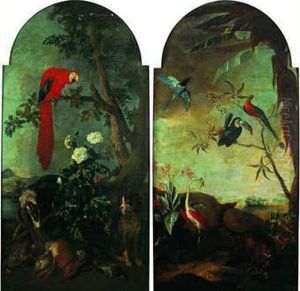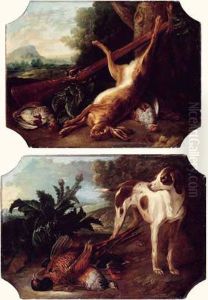Alexandre-F. Desportes Paintings
Alexandre-François Desportes, born in 1661 in Champigneulle, Ardennes, France, was a pioneering figure in French Baroque painting. Renowned for his realistic portrayals of animals, still lifes, and hunting scenes, Desportes infused his works with a dynamic quality that was innovative for his time. His talent was recognized early on, and by the age of 12, he was sent to Paris to study under the Flemish painter Nicasius Bernaerts, a student of Frans Snyders known for his animal paintings. This training laid the foundation for Desportes' future success.
Desportes' career took a significant turn when, in 1695, he was commissioned to accompany King Louis XIV on a hunting expedition as a painter. This opportunity not only elevated his status but also allowed him to observe his subjects in their natural habitat, enhancing the authenticity and vitality of his work. His ability to capture the essence of the hunt, combined with his skillful depiction of animals, earned him the patronage of the French aristocracy and royalty. He was appointed Peintre de la Chasse (Painter of the Hunt) for Louis XIV, a role that solidified his reputation and influence.
Throughout his career, Desportes not only produced hunting scenes but also contributed to the decoration of several royal residences, including the Palace of Versailles, the Château de Marly, and the Grand Trianon, showcasing his versatility as an artist. His still lifes, often including game animals and elements of the hunt, were celebrated for their detail, composition, and the way they reflected the opulence of the time.
Desportes' influence extended beyond his immediate era. He played a crucial role in the development of animal painting in France, inspiring later artists like Jean-Baptiste Oudry and François Boucher. His work represents a bridge between the Baroque sensibilities of the 17th century and the emerging Rococo style of the 18th century. Alexandre-François Desportes passed away in 1743, leaving behind a legacy that significantly contributed to the evolution of French art, particularly in the genres of animal painting and still life.

